As I traversed the city, snow still lay piled up on the sides of roads. Occasionally I would come across folk digging out their cars or improving access to their building, the snow being shovelled straight onto the roads where passing vehicles turned it to slush. I made my way to where 46th Street meets the Hudson River. Here I found the Intrepid.
The Intrepid Sea, Air & Space Museum is dedicated to the exhibition and interpretation of history, science and service as related to its home aboard the aircraft carrier Intrepid, a National Historic Landmark. All five of the U.S. armed forces are represented through these displays: The Army, Marine Corps, Navy, Air Force and Coast Guard.
Pier 86 is home to Intrepid. Further down the pier I spotted a Concorde, and also moored by the pier was the submarine Growler.
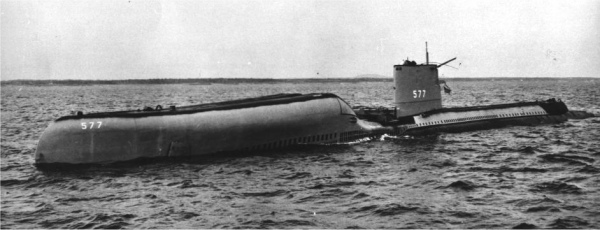 USS Growler (SSG-577) |
The Growler was the second and final submarine of the Grayback class, named after the Growler type of Largemouth bass - the practice in the day to name submarines after carnivorous fish. The USS Growler (SSG-577) was an early attempt by the U.S. Navy to field a cruise missile submarine which would provide a nuclear deterrent using its second series of cruise missiles. Her mission was to provide nuclear deterrent capability off the Pacific Coast of the Soviet Union during peak years of the Cold War, from 1958 to 1964.
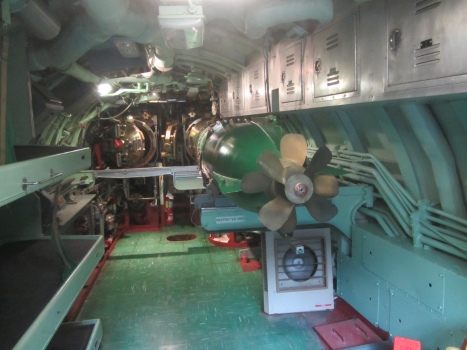 Aft Torpedo Room |
Growler was commissioned on 30th August 1958, and between 1960-63 conducted eight patrols in the western Pacific Ocean, each of which lasted about two months. After only six years in service, the submarine was decommissioned on 25th May 1964. It was scheduled to be destroyed as a test target, but was saved to become the only surviving submarine of its class and part of the Intrepid Museum.
I clambered aboard, and headed below decks. It was a case of a slow, self-guided weave through narrow corridors amongst pipes, valves, and by today's standards, antiquated technology. The crawl gave a first-hand look at life aboard a submarine and a close-up inspection of the once "top-secret" missile command centre.
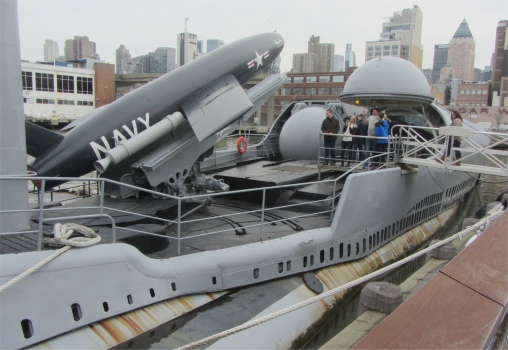 Cruise Missile and Launcher on Growler |
Having done Growler some justice, I crossed the pier and boarded the aircraft carrier. On 1st December 1941, just six days before the Japanese attack on Pearl Harbour brought the United States into World War II, the keel for USS Intrepid was laid and its construction began. Intrepid was launched in 1943, and served in the U.S. Navy for over three decades and played a role in World War II, the Cold War, the Space Race and the Vietnam War. After this storied career, Intrepid was decommissioned in 1974 and later opened as a museum, where the history of the ship and its crew inspires visitors from all over the world.
Intrepid had indeed a far more chequered history than Growler. USS Intrepid (CV-11) was commissioned at the Newport News shipyard in Virginia on 16th August 1943. The ship steamed through the Panama Canal to join the fleet fighting in the Pacific War. In February 1944, Intrepid participated in a major offensive against the Japanese base on the island of Truk. A Japanese air-launched torpedo hit Intrepid, jamming the rudder. Eleven men were killed. The ship headed to Pearl Harbour and then San Francisco for repairs. Back in action, Intrepid participated in the Battle of Leyte Gulf in October 1944, one of the largest naval battles in history. Intrepid planes helped sink the Japanese battleship Musashi. On 29th October 1944, a kamikaze smashed into a gun tub on Intrepid's port side. A gun crew of African American sailors, who usually served as cooks or waiters in the officers' mess, courageously fired at the airplane as it crashed into their position. Ten men lost their lives. During action in the Philippines, two kamikaze airplanes crashed into Intrepid within minutes of one another on 25th November 1944. Sixty-nine men were killed, making this attack the worst in Intrepid's history. Intrepid participated in the Battle of Okinawa, a massive amphibious assault that would last nearly three months. On 16th April 1945, a kamikaze airplane plunged through Intrepid's flight deck, killing nine men. The ship returned to San Francisco for repairs. Intrepid returned to the Pacific War just before Japan surrendered. Intrepid supported the occupation of Japan until December 1945. The U.S. Navy no longer needed a massive fleet, and Intrepid was decommissioned and put in mothballs, the reserve fleet.
In 1952-54, Intrepid underwent a modernisation program to accommodate new jet aircraft. The ship was recommissioned on 18th June 1954. In September 1956, Intrepid sailed to the Brooklyn Navy Yard for a seven-month modernisation overhaul, which included the installation of the angled flight deck and the mirror landing system. During the 1950s and 1960s, Intrepid made numerous Mediterranean cruises. The ship participated in military exercises and showed support to American allies in the region. In 1962, Intrepid was reclassified as an anti-submarine warfare carrier with a new mission of tracking Soviet submarines.
On 24th May 1962, Intrepid served as a primary recovery vessel for the Mercury-Atlas 7 space mission. Helicopters from the ship picked up astronaut Scott Carpenter. Three years later, Intrepid helicopters recovered Gemini 3 astronauts John Young and Virgil "Gus" Grissom and their space capsule on 23rd March 1965.
In 1966, Intrepid was converted to a "special attack carrier" and was deployed to Vietnam, where the ship served three tours of duty between 1966 and 1969. Aviators bombed strategic targets in North and South Vietnam as part of Operation Rolling Thunder. Intrepid aviators attacked a range of targets, including transportation links, petroleum resources and industrial facilities. Intrepid pilots scored two shoot-downs of North Vietnamese aircraft. Three pilots became prisoners of war, and 21 men lost their lives in combat or in operational accidents. In 1970, Intrepid returned to an anti-submarine warfare role, tracking Soviet submarines in the North Atlantic Ocean and the Mediterranean Sea. By this time, the Navy was phasing out smaller, older aircraft carriers like Intrepid. On March 15, 1974, Intrepid was decommissioned at Quonset Point, Rhode Island. New York City developer and philanthropist Zachary Fisher spearheaded a campaign to save Intrepid from the scrap yard. The ship opened as the Intrepid Sea, Air & Space Museum in 1982, and Intrepid was designated a National Historic Landmark in 1986.
In more recent times, immediately after the 9/11 tragedy, Intrepid was commandeered to house 500 FBI agents.
I booked up for two tours on the ship. After a brief walk exploring of the hanger deck, I embarked on a guided tour of the Enterprise Experience. Amazingly, I was the only person on the tour. A young fellow was my guide, complete with an iPad velcroed to his arm, and he gave me a comprehensive account of the history of space exploration, starting with the early dreams created by the Jules Verne 1865 novel, "From the Earth to the Moon". A chronological progression followed through Wernher von Braun's development of the V-2 rockets, the Mercury, Gemini and Apollo programmes, before the need to reduce costs resulted in the proposal for a reusable spacecraft being put forward. Although the concept had been explored since the late 1960s, the programme did not formally commence until 1972.
This lecture occupied half of my guide's allotted time. It was so enthusiastically delivered that I asked him what his background was in this field. "Oh, I obtained a degree in history, but always had an interest in space exploration. I combine my academic background with my special interest in this job aboard the Intrepid," he replied. This explained the 30 minutes lecture.
The lad took me up to the flight deck, where upon the stern stood the Space Shuttle Pavilion which showcased the Space Shuttle Enterprise, the prototype NASA orbiter that paved the way for America's successful space shuttle programme.
In 2012, the Intrepid Museum successfully transported Enterprise to its new home in a series of carefully orchestrated movements. The journey started in April when Enterprise was flown from Washington, DC to JFK Airport atop a specially outfitted 747 NASA Shuttle Carrier Aircraft (SCA). Next up, the orbiter was carefully craned onto a barge for a multi-day trip from JFK to New Jersey and then up the Hudson River, passing the Statue of Liberty and the Freedom Tower, to the Intrepid Museum. On 19th July, the Space Shuttle Pavilion, featuring Enterprise, opened to the public with much fanfare during SpaceFest, a five day public event featuring astronaut appearances, NASA displays, a concert and special movie screening. Unfortunately, when Hurricane Sandy struck the area on 29th October 2012, the Space Shuttle Pavilion was damaged, but reopened in July 2013.
 Space Shuttle Enterprise |
Space Shuttle Enterprise was built for NASA as a high-altitude glider for part of the Space Shuttle programme to perform atmospheric test flights after being launched from a modified Boeing 747. It was constructed without engines or a functional heat shield, and was therefore not capable of spaceflight. Enterprise's first test flight was on 18th February 1977, only five years after the Shuttle programme was formally initiated; leading to the launch of the first space-worthy shuttle Columbia on 12th April 1981 on STS-1. The Space Shuttle programme finished with its last mission, STS-135 flown by Atlantis, in July 2011, retiring the final Shuttle in the fleet. The Space Shuttle programme formally ended on 31st August 2011. Only six shuttles were ever built; sadly two were lost due to accidents.
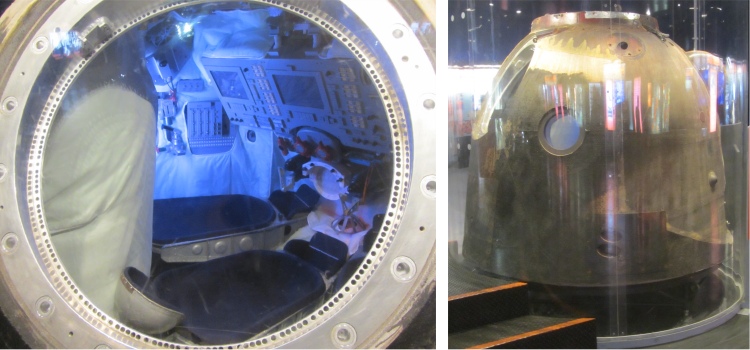 Soyuz TMA-6 |
After one hour exactly, the young man wrapped up his presentation, wished me a nice day, and went off to pick up his next group.
I made my way out to the flight deck, a most impressive expanse of steel turf, over 840 feet in length and 109 feet wide at the widest, backed by the majesty of Manhattan's skyline. Parked up were an array of aircraft and helicopters that do the air museum proud. I spent well over an hour wandering around this impressive collection. Ten aircraft on the flight deck have a direct connection to the Vietnam War, including the F-8K Crusader, A-1 Skyraider, F-4N Phantom and the iconic helicopter UH-1A Huey. Also on display are two Soviet-designed MiG fighter jets. From the Avenger torpedo bomber, a stalwart from Intrepid's World War II service, to the A-12 Blackbird, the formidable spy plane from the Cold War, the whole collection reflects some of the greatest achievements in military aviation.
 Looking Along the Flight Deck Towards the Bow |
 Looking Along the Flight Deck Towards the Stern, the A-12 Blackbird on the Right |
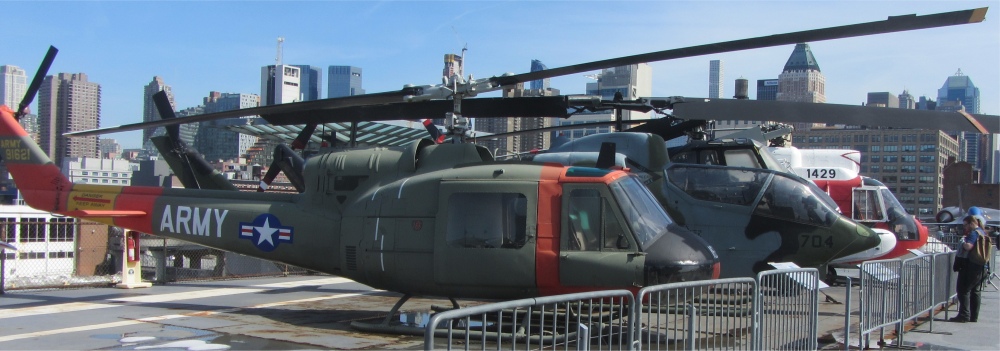 A Swarm of Helicopters, a UH-1A Huey at the Front |
 British Aerospace AV-8C Harrier Jump Jet |
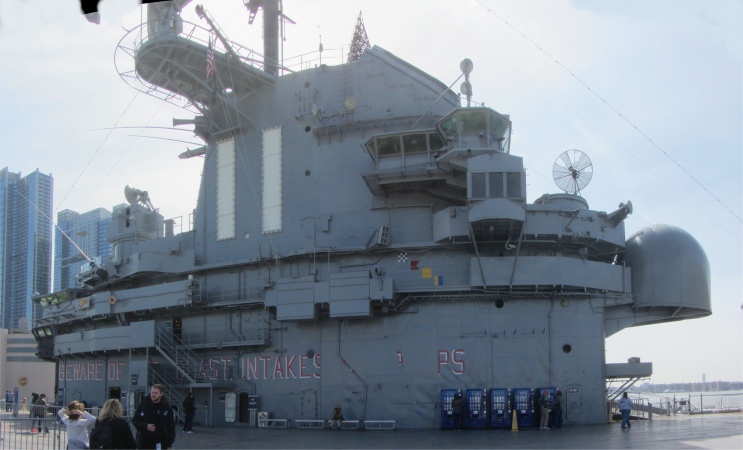 Intrepid's Island |
 Intrepid's Bridge |
After her thorough historical account below decks, she led us out through a side door, reserved for guided tours only, and we were soon standing on a wooden floor, teak to be exact, sharing it with a small light aircraft. Then without warning, the floor started moving up slowly, from the hanger deck to the flight deck. "When the ship was operational, this lift would transport planes up to the flight deck in 7 seconds," she declared.
The kids of a family in the group were gobsmacked. The family consisted of a dad, mam, and two boys and a girl. The guide occasionally tried to engage the kids through question sessions and role playing. The youngest, the girl, responded well to this. The middle boy was a Kevin, and he clearly disapproved of getting involved. I noticed anxious looks from his mother. His dad frowned heavily.
 Lockheed A-12 Blackbird |
The Blackbird was our guide's finale, and she wished we enjoy the rest of the ship and departed below decks. The dad of the family now had time for a chat, and we talked about Britain's current woeful lack of aircraft carriers, but I added the new two island carrier is in the pipeline.
"Did you vote for Brexit, or against it?" he enquired. I explained my reason for voting for Brexit, raising TTIP as one of them, which did not seem to offend him. "I work in IT," he stated, "and from that stance I and my co-workers see Brexit is important and the right move. I am of the opinion of ...... " Sadly, before he could continue, his family had dragged him off to the hanger deck. That was a pity really, I would have loved to hear his thoughts on Brexit and his views on Trump.
 Intrepid's Hanger Deck |
 British Airways Concorde Alpha Delta G-BOAD |
Instead, I walked past to the end of the pier to gaze out over the Hudson River, before a woman paraded around unceremonially informing folk that the museum would be closing in five minutes. I tarried a while, watching the numerous ferry boats that plied back and forth between Manhattan and New Jersey.
I headed back up 46th Street and once I hit Broadway I looked around for a food establishment; not difficult in this vicinity. This area, as darkness approached, is magical. The pavements are crammed with folk, the buildings bedecked with colourful neon lights and large flat screens. Almost every other building is a theatre or cinema.
 Lights in Broadway |
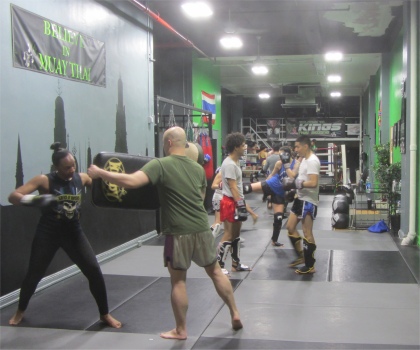 Kick-Boxing Club on 43rd Street |
I ignored the Charlie Wells, Boddingtons and Newcastle Brown Ales in the pub (honestly, can they be regarded as craft ales?) and sampled Founders All Day IPA and Goose Island. I was not disappointed.
On my way down to 33rd Street station, I came across lots of individuals dressed in yesteryear clothing, clutching at takeaway coffee cups, quietly asking passers-by if they could spare any change. Huddled masses of rags lay in doorways, and in the station other huddles lay in whatever out-of-the-way places they could find. There was an inordinate number of homeless on the streets and subways. New York may have significantly reduced crime on the streets over the previous 25 years, but the homeless situation refused to go away.
